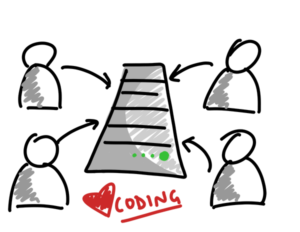Want to start a website department in your agency? Cool!
Here are some of the main things you’ll need to start a website design & development business.
The List
 1. Designers
1. Designers
When it comes to the website business, how good something looks is as important as how well it works. Because here’s the thing – no-one trusts a dodgy looking website. It doesn’t speak well to the audience. It doesn’t intrigue, welcome or wow.
Warning: a lot of web developers say they are web designers, but don’t mix the two! I’ve been in this business for over a decade now and the change of finding a web developer who’s a great designer is slim.
Web design and web development aren’t interchangeable words. They are completely different skill sets. They require a different frame of mind. Different ways of thinking. They’re really different, but they both need each other.
Now if you’re running an advertising agency or branding agency and you already have graphic designers, you could get them to design websites. But they need to understand some basic website principles first. Like grids, resolutions for web and most importantly, responsiveness – how to make a design work on tiny phones, from the older iPhone 4’s (640px) right through to the phablets of the world, like Samsung’s Note 8 (1,440px).
 2. Developers
2. Developers
Now that you have a sexy photoshop file created by your designer, you’ll need a good web developer to turn those static layers into a real, live website.
One of the most important things to look for here is attention to detail. Developers, being different to designers, can overlook small design details. It’s important that they take their time, work carefully and work to pixel perfection.
It’s not hard to find a developer, but it’s harder to find one who appreciates all the minor details of a design. Space and sizing inconsistencies are the easiest way to make a good design look crap when it’s been built.
And as with most things in life, you get what you pay for.
3. Someone with SEO coding knowledge
Ok, this doesn’t have to be a 3rd, new person – but it has to be someone you have on your team.
Someone needs to understand how to design and code for search engine optimisation. This can be learnt fairly easily though. The Moz Blog is a great place to start.
 4. A development hosting server
4. A development hosting server
Things break. Technologies need updating. Tests strain.
The last thing you want is something in development to block up resources on a live server. Resources that are serving live client websites. Where real users are. Where clients are. Don’t mix them!
I’ve seen this happen particularly when doing some work on an existing website (as opposed to a new build). Client requests new feature or change.
Easy option: log into the site and do it.
Proper option: clone the live website to a development, staging one and do it there. Better to be safe than sorry. Clients will appreciate this!
 5. A live hosting server
5. A live hosting server
Ok, this one can be a real P.I.T.A. When it works – sweet! It almost makes it feel like a set and forget. But that couldn’t be farther from reality. Servers need monitoring, maintenance, upgrades and a big focus on security to minimise website hacks and disruptions.
There are plenty options out there though – from shared services to dedicated. Be prepared to spend a fair bit of time figuring out what you need and then maintaining it. Better yet, pay someone who knows what they’re doing. (Seriously. I’ve done both and tried it all.)
6. Knowledge about DNS, A records, MX records, and more technical domain jargon
Ok, this can be your web developer. But if he/she is not in-house, you need to make sure someone internally knows this stuff. Because when these things break, clients get annoyed. And fast.
Broken A records will take down a site.
Broken MX records will disable their email systems from sending, receiving …or both.
Botched DNS records can do all of the above.
This is the sort of thing that gets a very quick, inbound call from a client. And needs to be rectified quick smart. You don’t want to be waiting around for another time zone for someone to fix this sort of thing.
 7. A support/maintenance plan (what do you do if a client’s site gets hacked?)
7. A support/maintenance plan (what do you do if a client’s site gets hacked?)
Ah, the forgotten post-service aspect of the web business.
So forgotten, in fact, that the web business has gotten a pretty bad repuation for not being there (read: available, responsive, reliable) when it’s needed most.
Do this part right and you’ve got a loyal web client for a very long time.
 8. Support person or team member who can troubleshoot the internet
8. Support person or team member who can troubleshoot the internet
Client’s emails are broken and they call you to find out why. It may not be related to any of your work, but if you’ve handled their website design project, expect a call. Because now you’re the web expert!
This can be your DNS/A/MX/tech jargon details person. Just make sure they’re available.
This person should also be able to fix errors on websites, like broken links, broken pages and buttons, contact form issues, etc etc. A lot of the time this person is the web developer – and that’s fine! But when you’ve got 1 developer, 2 urgent website deadlines looming in the next 3 days, you’ll wish you had the extra coding hands available. Support issues can steal hours out of a developer’s day. Vital hours. And attention. Disrupted time and thinking can lead to missed deadlines, overlooked attention to details and bugs.
Now, sure, it’s possible to have one super person who can be a couple of those items in one… but in a way, they’re even harder to find.
So if you want to start a website business or department within your existng agency, you can print this off, use it as a checklist and away you go.
Is this the only way?
But here’s the thing. Do you really need to? Or are there alternatives?
If you’re that way inclined, by all means, power to you!
But if you’re looking at that list and wondering where to start, or where you’ll find the time, not to worry – you’re not alone!
Let’s take a step back here for a moment.
Say you have an idea to create the next cool, modular, reusable mobile phone… and you wanted to make it a reality.
You have a couple of options;
Scenario 1
Start a technology company. Hire engineers. Product designers. Buy a factory. Deck it out with robots. Find some labourers. Make a prototype. Find the bugs. Go back to the drawing board. Make some more of them. Buy hundreds of thousands of dollars worth of inventory. Ramp up the production. Look into product packaging. Buy a packaging machine. Get some stickers. Pay a friend to pack the boxes. Find a shipping partner. Become an ‘overnight success’, many years later.
Scenario 2
Find a cool product manufacturer you can partner with who’s already got all that stuff. Sign some NDA’s. Communicate your idea. Get them to make it. Sell your products. Boom.
Ok, I oversimplified #2 for effect. But then again #1 is way more complex than I described it too. But you get what I’m saying.
There is another way!
Here’s an alternative
(Shameless plug time. Because we’re good at what we do!)
So if you’re strapped for time and don’t want to go through all the hassles, headaches, heartaches, tears and potentially wasting money by going through Scenario #1, you’ll be glad to know that there are companies that can help you with Scenario #2!
If you wanted to create another iPhone, you’d go and chat with the people at Foxconn. (Aside: cool name, right? Sounds the name of a business out of a Marvel movie!)
And if you want to start offering your clients website services, there’s us!
See you in the next one.
Ovi Puscas


